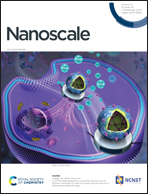Rapid determination of the presence of EGFR mutations with DNA-based nanocalipers†
Abstract
Selecting 1st-line treatment for lung cancer is currently a binary choice, either chemotherapy or targeted medicine, depending on whether EGFR mutations exist. Next-generation sequencing is fully capable of accurately identifying EGFR mutations and guiding the usage of tyrosine kinase inhibitors, but it is highly expensive. Moreover, as the sequencing is not helpful for patients with wild-type EGFR, the long wait for sequencing may delay the chemotherapy and correspondingly increase the risks of cancer progression. To address this issue, a new method for rapidly determining the presence of EGFR mutations is developed in this study. A series of DNA origami-engineered nanocalipers are designed and constructed to determine the EGFR spatial distribution of either mutated EGFR or wild-type EGFR lung cancer cells. The experimental results on cancer cell lines and 9 clinical tissue samples show that compared with wild-type EGFR cells, mutated EGFR cells have narrower EGFR spacing. Hence, the DNA nanocalipers are demonstrated to be capable of determining the presence of EGFR mutations and shrinking the detection period from weeks to hours, compared with sequencing. For determining EGFR mutation status in 9 clinical samples, DNA nanocalipers show 100% consistency with next-generation sequencing.



 Please wait while we load your content...
Please wait while we load your content...